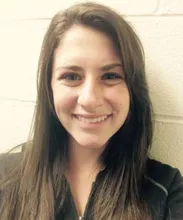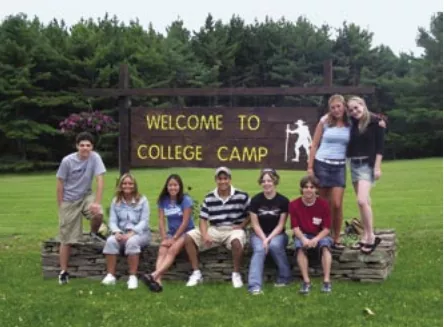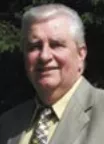Providing the comforts of home is what Oneonta Auxiliary Services (OAS) is all about. We're a not-for-profit corporation that has served the students, faculty and staff of SUNY Oneonta for more than 70 years. We oversee dining, retail, textbooks, vending, laundry, identification cards, ATM's and other essential services. We also own and operate a fabulous College Camp when you need to get away from it all.
Comforts of Home
From late-night snacks to an app that lets you know when your laundry is done, we do our best to provide all the comforts of home - and then some:
- Oneonta Auxiliary Services contracts with the Refrigerator Leasing Company to offer MicroFridge and refrigerator
- Have the food you want, when you want it. Late night snacks, meals, and drinks are always within reach.
- Choose from several models and sizes to suit your needs.
- The Refrigerator Leasing Company delivers and picks up.
- Submit an order with the Refrigerator Leasing Company at mymicrofridge.com.
High efficiency Maytag front loading washers & dryers are located in all residence halls.
- Use ONLY HE liquid detergents.
- Machine use is unlimited, no quarters needed!
Check out your laundry room at LaundryView!
Vending machines are conveniently located in many academic buildings and in all residence halls.
- Swipe your ID Card to use Retail Dining Dollars or Dragon Dollars.
- All machines accept cash, and debit/credit cards
- Use the Vending Hotline 607-436-2331 to report lost funds and/or broken machines.
Check cashing is available at the ID/Dining Card Office in the Red Dragon Outfitters for students, faculty and staff.
- Monday - Friday 8 a.m.-4:30 p.m. when classes are in session.
- Personal checks or off-campus payroll checks, up to $150.00 per week.
- Campus issued payroll checks and refund checks up to $600.
- Starter checks are not accepted.
- SUNY Oneonta ID Card is required.
- $1.00 check cashing fee.
Three ATMs are available on campus:
- Community Bank - Hunt Union
- NBT Bank - Hunt Union
- Sidney Federal Credit Union) - Mills Hall
Each ATM charges a $2.00 transaction fee.
Textbooks
OAS partners with eCampus to offer an online platform for textbooks. eCampus is a leader in online textbook services and provides comprehensive textbook and course material solutions completely online through 24/7 access.
Student FAQs
eCampus is SUNY Oneonta's official bookstore and by ordering through the Online Bookstore, eCampus guarantees you will receive the correct items for your courses. eCampus also has a dedicated customer service department to answer any questions you have. Finally, eCampus monitors all orders daily to ensure you receive books as quickly as possible and before the start of class.
If you do not see a textbook listed for a particular class, this could be because either there is no text required for the course or the instructor has not yet made a textbook decision. You will need to check back periodically to see if a book has been added.
The Online Bookstore’s goal is to offer students the most competitive price for their textbook purchases. With our competitive pricing model, textbook prices are subject to change based on market prices and inventory conditions.
Marketplace books are items listed and shipped by individual sellers, such as other students and parents. These sellers must confirm your order within three business days. Each marketplace book has its own condition description and shipping cost associated, so please be sure to read the item’s description before ordering. Not all marketplace items are available for expedited shipping and these items will arrive separately from the rest of your order.
Books are shipped based on availability. The availability of each book will be indicated under the condition of each item. If a book is in stock and your order is placed before 11:00 a.m. EST, it will ship same day. Any orders placed after 11:00 a.m. EST will ship the next business day. If all items are not in stock, your order will ship complete. This means the order will be held and shipped once the entire order is filled. If the order has not yet been filled and it is within two weeks of the course start date, items will ship as they become available and you may receive multiple packages. Your books will be shipped via your selected shipping method and delivered Monday through Friday.
When entering shipping information, you will have the option to check the “Ship to Campus” box to ship directly to your campus. You may also choose to ship your books to your home address or an alternate address.
Yes. If you have funds loaded to your student account you may use that to purchase your textbooks. The funds will be available to apply to your purchase on the payment screen. If your funds do not cover the cost of the order, you will need to use a credit or debit card to cover the remaining total.
If you are renting any of your textbooks a credit card is required to keep on file as collateral. In the event that your rental book is not returned by the rental return date or is returned damaged your card will be charged the price of a new copy. The card must have an expiration date that is beyond the rental return date to be accepted. If the rental textbooks are returned to us on time and in good condition, this credit card will not be charged.
Your credit card will be authorized and charged upon placing your order. If you are renting books, your card will remain on file in case the rented items are not returned in saleable condition or not returned at all.
Yes, you can use your campus card to place an order. If you have a family member that wants to help pay for your books, they can purchase eCampus gift certificates by visiting the Online Bookstore and selecting “Gift Certificates” at the bottom of the screen under “Quick Links”. Please note – these gift certificates are for use at the eCampus Online Bookstore only.
Select “My Account” at the top-right corner of the SUNY Oneonta Online Bookstore. After signing in to your account, you can check the status of your order, buyback, or return.
Yes, eCampus accepts debit cards, as long as they have the VISA or MasterCard logo. eCampus also accepts Visa, MasterCard, American Express, Discover credit cards, and PayPal for payment of online purchases.
Please contact the eCampus Online Bookstore Customer Service department:
Phone: 859-209-6958
Email: bookstore@ecampus.com
Bookstore
The Red Dragon Outfitters offers a variety of school supplies, Oneonta fashions, workout gear, gifts and more. To meet your classroom needs, we partner with eCampus.com, an online textbook store offering new, used, rental and ebooks.
Dining
Whether it’s breakfast at Wilsbach Dining Hall, a quick cup of coffee at Starbucks, or a late-night snack at the Mills Marketplace, we are dedicated to delivering quality product at reasonable prices. OAS is proud of our partnership with Sodexo Dining Services, and together we seek to offer new concepts in welcoming venues.
All students living on campus are required to have a dining plan. Commuter/off-campus students are not required to have a dining plan.
University ID Cards
ID/Dining cards are your:
- Official Campus Identification
- Student Activity Card (SAC)
- Bus Pass
- Door access to your residence hall and across campus
- Dining Plan
- Retail Dining Dollars
- Dragon Dollars
- Library Card
- Access to fitness centers
Retail Dining Dollars are for on-campus non-taxable food purchases and are non-refundable.
About Retail Dining Dollars
- You can purchase food at any of our campus retail food operations - Starbucks and Mills Marketplace, Argo Tea and Seasons, at any vending machine on campus, or for food items at the Red Dragon Outfitters.
- Additional Retail Dining dollars may be added at any time
- Retail Dining dollars may be carried over from fall to spring semester, but not from spring to fall. Due to NYS sales tax regulations, Retail Dining dollars may not be refunded.
Dragon Dollars is an optional spending account that may be used on campus and at participating off campus restaurants for a variety of purchases, and are refundable.* Dragon Dollar gift cards are also available for sale and may be used anywhere Dragon Dollars are accepted.
Where are Dragon Dollars accepted?
On-campus uses include:
- Purchases at the Red Dragon Outfitters-O-State apparel, supplies and more.
- Textbooks from eCampus.com
- Purchases from the Marketplace.
- Food at any dining facility.
- Pay parking fees & fines.
- Vending machines.
- CUAC tickets.
- ORC trips.
- Purchase additional computer print quota.
A variety of off-campus eateries accept Dragon Dollars.
How can I fund my Dragon Dollars account?
- Check the appropriate box on the university bill.
- Call the ID/Dining Card Office at 607-436-3367 (credit/debit cards).
- Visit the ID/Dining Card Office in the Red Dragon Outfitters (credit/debit cards, checks & cash accepted).
- Login to Get.
How can I purchase a gift card?
- Call the ID/Dining Card Office at 607-436-3367 (credit/debit cards).
- Visit the ID/Dining Card Office in the Red Dragon Outfitters (credit/debit cards, checks & cash accepted) .
- On the Red Dragon Outfitters website.
*Dragon Dollars balances that exceed $15 are refundable upon request at semester end or upon separation from SUNY Oneonta. All Dragon Dollar refunds are subject to a $10 processing fee.
GET is a convenient web service providing 24/7 access to Dragon Dollar and Retail Dining Dollar accounts. Login to GET and you will be able to view your account histories, deposit money, deactivate card services due to a lost or stolen card, and more...
NOTE: Availability of money added to the ID card through the student bill may be affected by financial aid disbursement policies.
New students may upload a selfie photo by following the steps below, your card will be printed and waiting for you when you arrive on campus.
Photo requirements
- Must be in color.
- Recent (no older than 6 months).
- JPEG (JPG) file format, less than 1 MB in size.
- Portrait style, eyes to camera, head centered with extra space on all sides.
- Plain white or blue background.
- NO other people, hats, profile shots, sunglasses, gestures, or anything shielding your face.
- Photos that do not meet these requirements will not be processed. If your photo was not accepted, you will be notified.
- Be sure you like your photo. There is a $20 fee for a replacement ID/Dining card.
How to take a selfie
- Stand or sit against a plan white or blue background.
- Have someone stand at least 3 feet away from you with your face centered in the photo screen and smile.
Submit your photo online
- Log into GET using your Oneonta username and password
- Click on Submit ID Photo.
- Click on Browse to find your photo.
- Select photo, then click on Upload.
Note: Returning students are welcome to send us a selfie to update your photo on your ID/Dining card; but please note that there is a $20 fee for a replacement card.
How to pickup your ID card
You must show a valid government-issued photo ID to pick up your ID/Dining Card. You will be the only person allowed to pick up your card. Cards may not be mailed.
Questions? Call the ID/Dining Card Office at 607-436-3367.
Good Example
Bad Example
There are three ways to report a lost ID/Dining Card.
- Monday - Friday 8:00 a.m. - 4:30 p.m. (when classes are in session) call the ID/Dining Card office at 607-436-3367 or stop by the office at the Red Dragon Outfitters.
- After hours, call University Police at 607-436-3550 or stop by their offices in Alumni Hall.
- You may deactivate your account online through GET via myOneonta, the GET mobile app, or directly through GET. This will only deactivate your dining plan and Dragon Dollars. You must still contact the ID/Dining Card Office or University Police to deactivate the door access.
Replacement ID cards are $20.00
ID/Dining Card Office
Red Dragon Outfitters
Monday - Friday, 8 a.m. - 4:30 p.m. when classes are in session
607-436-3367
College Camp
College Camp, a 276-acre site of former farmland and woodland, offers educational, recreational, and social opportunities for the SUNY Oneonta community. The College Camp is located at 119 Hoffman Road and is a cooperative venture of the Student Association, SUNY Oneonta and Oneonta Auxiliary Services.
Faculty, staff, students, and alumni of SUNY Oneonta are authorized to use College Camp property. Community members are welcome to use camp property only when invited as a guest of an employee or student of SUNY Oneonta.
For many years the students and faculty of the State University Teachers SUNY Oneonta have looked forward to having a camp for recreational and educational use. The dream was finally realized on August 15, 1952 when the Faculty-Student Association, Inc. purchased a sixty-three acre farm about four miles north of the College.
So begins the 1952 press release from President Netzer, announcing that the much-anticipated dream of having a college camp had finally come true. The old Hoffman farm couldn’t have been a more perfect location. There were endless possibilities in the hills, the woods, the open fields, the stream. Even the old buildings had potential. Bobbie Roman captured the feeling everyone had at of one of the very first tours of the Camp: “Our active imaginations ran wild. Our plans and excitement were boundless, our horizons “unlimited.” “Horizons Unlimited” immediately became the motto of the Camp, and to this day that motto lives on.
The Camp Planning Committee, made up of both faculty and students, had been formed in September 1952 to create a long-term plan for the operation and development of the Camp, along with a list of tentative rules for Camp use. Within just two months, both of these goals were met, along with a strong advertising campaign and preparations for winter sports activities. Project subcommittees of student and faculty volunteers soon formed to undertake such missions as campsite shelters, water supply and sanitation, Bugbee School camp, and project financing.
Due to the vision and hard work of a small core of dedicated people, much was accomplished in the next ten years. The upper picnic area was completed, a well was dug for drinking water, the house was cleaned and used for emergency quarters, trails were blazed, a small lake was built, there were group campouts and skating parties, and over 10,000 trees were planted by College and Bugbee School students.
The construction of a lodge was also a high priority from the beginning. Plans for a futuristic-looking structure fell through in 1958, and then in 1963, the lodge that we have today was built. The Lodge was used by many groups and clubs for meetings, social gatherings, and overnights. Individuals used the Lodge for study or just to relax. It eventually became so popular that a lottery system was devised to accommodate all the overnight requests. At the same time, the caretaker’s cabin was also built. Lyall Fletcher became the very first caretaker, followed by Ken Kellerhouse.
In 1970, a new downhill skiing complex was opened. There were contests for naming the ski area, and it was first called Cocaska and later renamed Dragon East Ski Area. In November 1975, Peter Dady became the first Director of the College Camp. New snowmaking and ski equipment were purchased, and more T-bars were added to the lift. Ski classes continued to be offered, and cross-country ski equipment was made available for rental.
In 1978 Sepp Rhoese was hired as the second College Camp Director. He was also the director of the downhill ski program. He strongly believed in the importance of a healthy body and a healthy mind. He began a ‘Winter Weekend’ tradition; he continued the annual Supergames, which were first begun in 1977, and he helped plan and create the Fitness Trail. Tragically, in March 1980, he was killed when a drunk man lost control of his speeding cattle truck, which rolled onto the car in which Sepp was riding. In the words of one editorial, “Inherent within his daily work was the joy which came from the seemingly endless time and energy which he devoted to the well-being of others. Once you met him, you never forgot him.”
Later that year, Snapper Petta was hired as the third Director of College Camp. One of his first goals was to make the Camp more than just a place to ski and have weekend parties. His goal was soon accomplished. He expanded Supergames and turned it into Super Weekend, complete with square dancing, the traditional Supergames (including such new competitions as apple pass, pitch the tent, and others), and the Sepp Rhoese Fitness Trail Run.
He also renamed the ski area to Dragon East Winter Recreational Area to reflect the fact that it is not just a ski area, but a true recreation area where everyone can come out to enjoy our central New York winters. By 1984, the downhill ski facility was phased out due to budget constraints. The Winter Recreational Area was still open for cross-country skiing, tobogganing, and other winter activities.
The use of the Camp during the non-winter months expanded as well, and included hiking, photography, camping, fishing, and other outdoor activities. There were many new programs, such as Moonlight Madness, Moonlight Cross-Country Ski Tours, winter camping, and Springfest. The ropes course was built in the mid-1980s and was updated and expanded in the summer of 2001. Two lean-tos were also built in conjunction with SUNY Delhi construction classes. Snapper's frequent articles in the State Times kept everyone informed with everything from frostbite to great recipes to try while camping.
From 1987 to 1992, Warren Weldon served as caretaker to the Camp. By this time, the College Camp had been expanded to 262 acres. In 1990, the decision was made to move the Observatory to the Camp in order to escape the lights of the city and the mist of the Susquehanna Valley. The Camp provided a perfect setting for the Observatory.
By the spring of 1993, College enrollment had dropped, and there just weren't enough funds to finance the Camp. It was announced that the Camp would be closed in December due to budgetary constraints. The Camp remained unused through the 1990s, and in May 1999 a tornado destroyed portions of the Camp property during the Memorial Day weekend.
Many people were very disappointed that the Camp had to be closed. They knew and appreciated what a treasure the Camp was to the College. They tried numerous times to find ways to make it possible for the Camp to be reopened. Finally in 2000, thanks to such efforts, the enthusiasm of the students, and the joint financial efforts of the Student Association, the College, and the Organization of Ancillary Services, the decision was made to reopen the Camp.
In April of 2000, cleanup of the property and buildings began. The picnic area was cleared, the areas around the lean-tos were dug out, and trees were removed. All the trails were cleared, the road was graded, ditches were cleared, new signs were posted, and trail markings were started. Lodge renovations included a new kitchen, a handicap-accessible bathroom, a ramp and steps into the building, renovations to the downstairs bathrooms (which included showers), a new furnace, foundation repair, and new drainage tile installed.
After a great deal of grounds-keeping work and renovation, the Camp was opened after a ribbon cutting on November 4, 2000. On May 3, 2001, the Lodge officially opened with a campus-wide celebration. According to Tom Ryder, Executive Director of OAS, “the imagination and vision of individuals began to shape the reopening of the Camp first very functionally and following that success and a great response from those using the facilities, an enormous growth in new facilities and programs” resulted.
From the beginning, a core group of people have seen the possibilities the Camp has to offer and have put their heart and soul into making the Camp what it is today. Through the hard work and vision of everyone devoted to the Camp, including the previous caretakers, Eric Oellrich, Tim Gargash, and the current caretaker, Mike Hurley, along with many others, the Camp has truly become a “wonderland.” In Tom’s words, “You will find this same kind of attitude throughout OAS staff, the College Camp Advisory Committee, and the OAS Board of Directors. Moving from a camp that we could simply ‘not afford’ in the early ’90s, to creation of a growing, active, and vital pillar of SUNY Oneonta, would seem to support the theme of ‘horizons unlimited!’”
This history is provided by conversations and correspondence with Colleen Brannan, Snapper Petta, and Tom Ryder, archival records of the Camp, the previous online history, and written by Heather Heyduk.
Works cited:
C.H. “Editorial: The Sunshine of Sepp.” State Times. March 7, 1980.
Gindin, Rona. “Snapper: Cooking It Up at Camp.”
State Times. September 23, 1980.
Netzer, R. F. College Camp: For Release. 1952.
Petta, Snapper. “The ORC Speaks.” State Times. January 30, 1981.
Roman, Bobbie. “Horizons Unlimited.”
State Times. October 3, 1952.
Nature has taken more care than the fondest parent for the education and refinement of her children. Consider the silent influence which flowers exert, no less upon the ditcher in the meadow than the lady in the bower. When I walk in the woods, I am reminded that a wise purveyor has been there before me; my most delicate experience is typified there. –Henry David Thoreau (1817–1862)
SUNY Oneonta Revives a Half-Century Old Recreational Learning Facility by Tom Ryder
This is the story of the College Camp at SUNY Oneonta – a wonderful 280-acre outdoor education and recreation facility that was closed for eight years due to a lack of funding. Sale of the property was being considered until a dedicated group of individuals found a great solution and “rescued” the Camp. Now, five years after reopening, the Camp and its programs are thriving. It’s a great story with a happy ending.
Over 50 years ago, the College’s auxiliary service, then called the Faculty Student Association (FSA), purchased a beautiful tract of former farmland within a mile of campus. The plan was to develop a facility that would provide a different and exciting perspective to what at that time was a state teachers college.
The Camp property at the top of a hill has a wide variety of deciduous and evergreen trees. Two small ponds are home to fish, frogs, and salamanders, and a small stream runs downhill through the property. Colorful blue jays, cardinals, and orioles flit through the trees. The white-tailed deer, fox, and smaller mammals thrive in this protected area, and occasionally a black bear is seen. The Camp is a treasure trove of flora and fauna.
The plan was to develop a facility that would provide a different and exciting perspective…
The first activities were field trips, overnight camping, and hiking. In the 1960s, the FSA Board authorized construction of a small cabin and a wonderful two-level, 2,500 square foot lodge, so faculty, staff, and students had an indoor location at the Camp for meetings, classes, and social events. The board hired the first caretaker. College Camp was designated as a primary field site for the science departments. Records from 1965 indicate that Camp facilities were used extensively with total registrations exceeding 5,000 for the year.
SUNY Oneonta’s 250-acre campus overlooks the scenic Susquehanna River Valley in central New York about halfway between Albany and Binghamton. On nearby Otsego Lake in Cooperstown, the College maintains a complex which houses its Biological Field Station and Graduate Program in History Museum Studies. Founded in 1889, the College at Oneonta became a charter member of the State University system in 1948. Today, the College enrolls more than 5,800 students in 69 undergraduate majors and nine graduate programs. A liberal arts college with a pre-professional focus, the SUNY Oneonta is noted for an outstanding and accessible faculty, students committed to both academic achievement and community service, excellent facilities and technology, a beautiful campus with a modern field house, and an exceptional library with the most volumes per student of the SUNY colleges of arts and sciences.
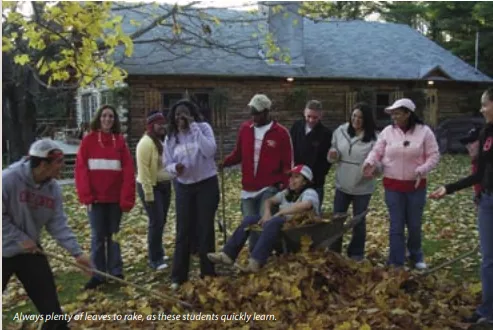
FSA tried something new in the 1970s – downhill skiing. Beautiful in the summer, the Camp is a true winter wonderland when that long season rolls around in upstate New York. Several small ski slopes were developed, complete with a T-bar lift, snow-making equipment, and a very modest ski lodge. Skiing was quite popular with students and the local community for many years. Eventually, cost, mild winters, and development of larger ski centers caught up with the operation, and downhill skiing was stopped in 1984.
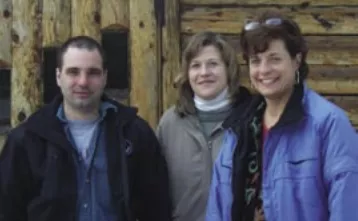
Administrative Team: (L-R) Tim Gargash, Caretaker; Tracey Lindberg, Executive Assistant; Colleen Brannam, Marketing & Publications Manager.
However, those involved with the Camp had worked to expand it in other ways:
- College students, many of whom hail from more urban areas of the state, enjoyed the outdoor activities, freedom of being away from campus, and social events held at the lodge. Eager student groups competed for reservations to use the lodge on weekends through a lottery system.
- Outdoor concerts were held on the property.
- Staff and volunteers continued development of the seven-mile marked trail system, later introducing a fitness trail that featured exercise stations at various points.
- Winter use increased with grooming of cross-country ski trails and snowshoeing.
- Educational programs expanded the use of outdoor areas of the Camp.
- The lodge was used frequently for weddings and other family events.
- Local not-for-profit groups, such as the Boy and Girl Scouts, were invited to use the facilities.
In 1987, the College’s Observatory moved to an open area of the Camp to avoid the light pollution from the City of Oneonta and another nearby college. Two large telescopes, one with a 16-inch lens and the other a 14-inch lens, are housed in structures next to a modular classroom, and seven 4-inch lens telescopes are located in sheds with removable roofs. The observatory added another dimension to the Camp and provided great opportunities for public events, advanced viewing, and digital imaging of planets, star clusters, and nebulae.
The late 1980s and early 1990s were difficult years for the College and the Camp. As enrollment declined, the auxiliary area was impacted heavily. Decreased enrollment resulted in a drop in the three auxiliary revenue centers: dining, bookstore, and vending. With a full-time caretaker/program director on the payroll along with maintenance and programming, the Camp’s annual costs were $75,000 with little or no revenue beyond a few modest fees.
In 1992, the Board of Directors of Oneonta Auxiliary Services (OAS, the not-for-profit corporation under contract with the College, which succeeded the Faculty Student Association) faced a difficult choice: closing the Camp or increasing dining rates substantially to keep it open. The Camp was closed, and over the next seven years, repeated attempts to reopen it failed because of the lack of funding.
Since the Camp still cost OAS $30,000 a year for heat, taxes, and other maintenance, the question soon became, “Can we find a way to reopen the Camp, or should we sell it?” Many were shocked at the thought of selling the facility, but that alternative had become a reality.
The Camp, a tradition of the College, was remembered fondly by alumni, some of whom were married there. Many faculty, who had used the facility so successfully, mourned its closing, and students for nearly a decade during the 1990s missed out on the memorable and unique experiences of the Camp.
Late in 1999, the OAS Board charged a new committee with resolving the issue of reopening. Meeting regularly, the members reviewed the budget, developed estimated costs, looked for revenue opportunities, and studied the work of prior committees. The dedicated group knew this could be the last chance for the Camp. The Committee’s recommendation to the board was that the Camp could be reopened successfully subject to the following conditions, based on estimated opening costs of $135,000 with an annual budget of $90,000:
- Significant financial support from the Student Association would be required.
- OAS would have to sell about 70 acres of additional land that was purchased in 1989 but never developed for Camp programs.
- Both OAS and the College would have to contribute.
Next, the Committee began an educational and informational campaign across campus, including presentations to the Student Association, the President’s Cabinet, and a number of administrative and staff groups. These presentations were made by Dr. Steven Perry, Vice President for Student Development. “I was convinced from my experience at the camp (prior to its close) that it held incredible potential to enhance the quality of student life and learning. I believe we needed to make the necessary financial commitment to preserve an irreplaceable asset for the College.”
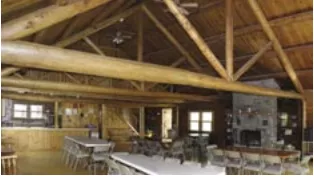
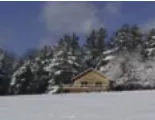
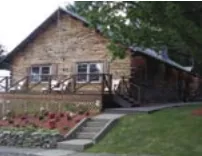
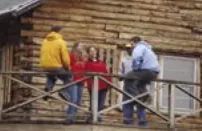
In addition, the Executive Director of OAS, Tom Ryder, along with former Camp caretaker/program director Snapper Petta, took groups of students to the Camp in vans to show them the facility and talk about the opportunities it could provide. Few of these students had ever seen the Camp, but they were very impressed and excited. Snapper recalls, “What I remember most is the look on everyone’s face. Once they saw the lodge, even it its rough form, they could envision the possibilities for programming, socials, and other gatherings. Each wanted us to reopen quickly so they could reserve the facility for themselves.”
Ultimately, it was the students’ enthusiasm that made the re-opening possible. Within three months, the committee presented its unique plan:
- The Student Association agreed to pay OAS $30,000 annually for three years, with an additional $30,000 to help with initial opening costs.
- OAS sold its excess property for $70,000 and used the proceeds to renovate the lodge.
- The College released a portion of Snapper Petta’s time to serve as the Camp’s program director. His experience with the Camp and his position in residence life as Director of the Outdoor Resources Center made him an ideal fit. An account for program supplies and materials, along with Snapper’s time, equaled a $30,000 contribution by the College.
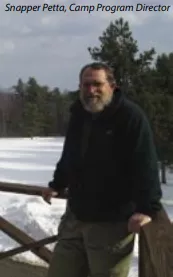
- OAS made up the difference in opening costs and used the $30,000 already budgeted annually for the Camp.
The OAS Board of Directors approved re-opening the Camp in fall 2000.
OAS then went to work bringing the long unused grounds and buildings back online, facing some major challenges:
- A severe tornado, very rare in New York State, had ripped across the countryside in May 1999, with the Camp in its path. Fortunately, there was no loss of life in the area, but the downed trees created significant obstructions and hazards. The cost of clearing trees to make the Camp safe for use was $25,000.
- The long-unused lodge needed substantial work, including correction of drainage problems to stop water from running through the lower level. Bringing the lodge up to code, installing a new kitchen, and adding an accessible bathroom cost $80,000.
- The 1.5-mile dirt road leading to the Camp needed new material and grading for about $17,000.
- Expenses such as new furnaces for the lodge and caretaker’s cabin, a handicapped/service entrance and ramp, and other repairs amounted to approximately $135,000 in total opening costs.
Just before the fall 2000 semester, the College celebrated the reopening of the Camp with a ribbon cutting. The Camp once again offered opportunities for outdoor activities such as hiking, trail biking, snow shoeing, cross-country skiing, and more. Outdoor programs, including an expanded challenge course, were re-established. Beginning in spring 2001, efforts turned to the lodge. After three months of work, including volunteer efforts by staff and students, the lodge hosted an open house. T-shirts commemorating the reopening read, “College Camp, a cooperative venture of the Student Association, the College at Oneonta, and Oneonta Auxiliary Services.” The phrase “cooperative venture” embodies the spirit of the efforts that rescued the Camp, and those who made it happen were proud of their accomplishment.
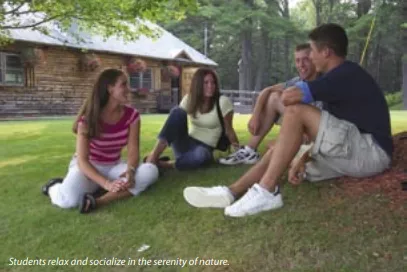
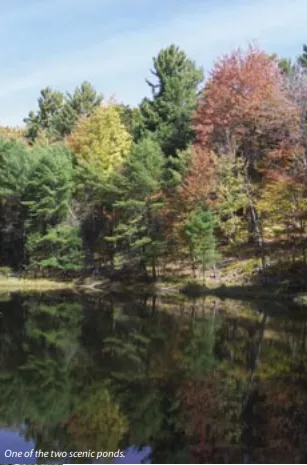
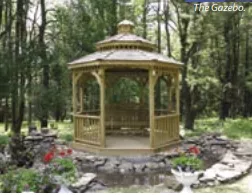
The opening of the lodge signaled a time of incredible growth in activity at the Camp. Consider this sample of what happened in the five years subsequent to opening:
- A reservation system was established, and events are scheduled at the lodge an average of five days per week year-round. In addition to classes, seminars, retreats, student club meetings, and general social activities, the lodge hosts, on average, four weddings a year. Almost 9,000 individuals were involved in reservations during 2003-04, a 15 percent increase over the previous year.
- The caretaker’s estimate of people on the grounds who are not involved in lodge reservations adds another 8,000 individuals who used the Camp for outdoor recreation, a 28 percent increase over the prior year. Between the two counts, the total annual usage amounts to 17,000.
- For the fourth successive year, new students and parents attending summer orientation (about 300 people in each of seven sessions) will visit the Camp for a barbeque under a big tent next to the lodge. This event gives new students exposure to the facility and has greatly increased participation at the Camp in subsequent activities.
- A Camp Advisory Committee of faculty, students and staff provides input for new activities and facilities, reviews proposals, and is directly involved in Camp functions.
- Increased programming includes more frequent use of the challenge course and annual events including Winterfest, a Yuletide Festival, and a Native American Festival.
- Educational activity in the observatory has increased and includes monthly programs for community members to use the telescopes.
- The Camp provides additional opportunities for our food service to cater events.
- Marketing of the Camp at Admissions open houses and across campus has grown substantially.
- New facilities built since the re-opening include a full basketball court, a sand volleyball court, a covered picnic pavilion, and a beautiful gazebo.
- Students will work on an arboretum this spring, complete with plaques that identify the species of trees.
- A five-year capital plan to expand activities and provide maintenance for the Camp is in place.
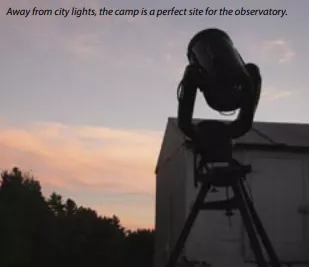

The opening of the lodge signaled a time of incredible growth in activity at the Camp.
- The College at Oneonta Foundation is considering a special campaign to establish an endowment for the Camp.
- The new caretaker, Tim Gargash, has lots of energy and good ideas. He will work this summer to prepare a skating area for next winter and to introduce some beehives with a unique cut-away viewing station for observers.
- The administrative team of Tim, Colleen Brannan (Marketing), and Tracey Lindberg (Executive Assistant) strives to keep the customers happy and smiling.
As promised, the story of the College Camp has a happy ending. Faced with the loss of a great place and a 50-year tradition, students, faculty, and staff pulled together to rescue a College Camp that has now been reestablished as a unique component of the College at Oneonta experience.
Tom Ryder is the Executive Director for Oneonta Auxiliary Services at SUNY Oneonta, where he has been for 38 years. During the time he served as Director of Student Accounts, he was one of the founders of the New York State Organization of Bursars and Business Administrators (NYSOBBA). He served as President and later became editor and publisher of NYSOBBA’s monthly newsletter. In 1988, Tom was appointed Associate Vice President & Controller, directing seven departments and providing direct support for the VP for Finance & Administration.
In 2000, having retired from the State of New York position he held at the College, Tom accepted the position of Executive Director of Oneonta Auxiliary Services. He is currently Vice President of the SUNY Auxiliary Services Association, and also serves on the NACAS Professional Development Committee.
Tom is married and father to five daughters, and grandfather to six children. He and his wife Linda live in Otego, New York.
The majority of College Camp is comprised of various types of forest that warrant various management techniques. In winter 2012-13 the Camp was surveyed by a state forester from the New York State Department of Environmental Conservation (NYSDEC) who compiled a complete analysis, description, and recommended management plan for the College Camp property based on the goals and mission of College Camp. A copy of the full Forest Stewardship Plan and Appendices can be found at the OAS office. A summary of key points of that Forest Stewardship Plan are given below.
The recommendations put forth in this plan have been prepared using guidelines from the United States Department of Agriculture, Forest Service – Forest Stewardship Program. The Forest Stewardship Program is founded upon the principle that natural resource management can best serve landowners and the public by taking a multiple resource approach to managing non-industrial private forests. This Stewardship Plan should be considered a living document that may be amended at any time to incorporate changes in landowner goals and objectives and/or the natural process. The Forest Stewardship Plan was constructed with the following goals in mind:
- To maintain the health of the forest.
- To maintain and/or improve the recreation access to the property for walking, hiking, mountain biking and nature and wildlife viewing.
- To manage the timber resource in a low impact and sustainable manner.
- To maintain native species of plants.
- To preserve the aesthetics of the property.
- To protect the soil and water resources.
- To maintain or improve the habitat to encourage a variety of plants and wildlife present on the property.
The Forest Stewardship Plan proposed by the forester from the NYSDEC is based on a ten-year work schedule. Annual activities include maintaining trails, inspection of property boundaries, mowing of fields. Each of the 15 forest stands (sections) should be selectively thinned in approximately 10-year intervals; thinning may be conducted on multiple stands at once for ease of logistics and minimization of time that the Camp is closed to users. Thinning will be conducted to promote the health of the forest and help pay for the operation of College Camp. Every 5 years the property boundaries will be remarked to preserve the integrity of Camp boundaries.
As per recommendation of the state forester and express interested of several stakeholders of College Camp the field areas will be left as open field areas for aesthetic purposes and to provide habitats for additional wildlife species. Management of these areas will be conducted with these two goals in mind. The Forest Stewardship Plan also includes recommendations for dealing with invasive plant species, which will be part of the regular maintenance of the Camp.
About OAS
OAS is governed by a Board of Directors comprised of students, faculty and administrators, and every one of our employees is committed to providing exceptional customer service and those little touches that make SUNY Oneonta your home away from home. As students, you are our most important customers, and we hope you’ll let us know how we can better serve you.
Sustainability
Sustainability means operating in such a way as to meet our needs without compromising the ability of future generations to meet their needs. OAS consistently works towards sustainability.
Contact OAS
Red Dragon Outfitters
SUNY Oneonta
108 Ravine Parkway
Oneonta, NY 13820
Tel. 607-436-3352
Fax 607-436-3642
